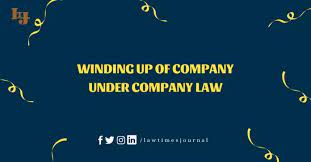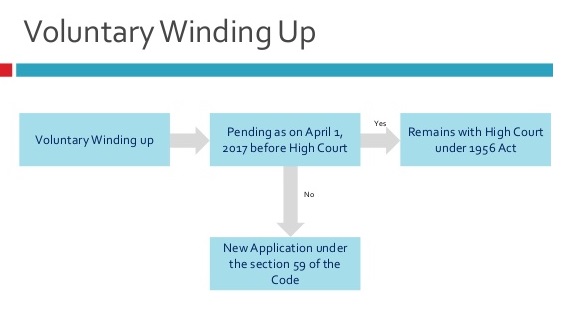Overview on winding-up of a company
Page Contents

Overview on Winding up of a Company
BRIEF INTRODUCTION
Winding up is the process involving liquidation of Company’s assets which are collected and sold so as to pay the debts incurred. Under the winding up process firstly the debts, expenses and costs are paid and any remaining amount is distributed among the shareholders.
Once the corporate is liquidated it’s formally dissolved and also the Company ceases to exists. Winding up is basically a legal mechanism to shut down a company and cease all the activities that re carried on.
Once winding up process is initiated against a corporate entity, its assets are monitored in such a way, so that the stakeholder’s interest does not get hampered.
Various aspects of winding up of a Company
A Private company is an artificial judicial person and requires various compliances if the corporate fails to take care of these compliances there are fines and penalties or may even be disqualification of the directors from further incorporating a corporate entity.
it’s always beneficial to wind up a corporate entity that has become inactive or where there isn’t any transaction.
The shareholders of the corporate can initiate the winding up of the corporate anytime. If there are secured or unsecured creditors or employees on roll then all the dues must be settled. After settling the dues it’s necessary to shut all the Company bank accounts.
The GST registration must even be surrendered just in case of Company winding up. Once all registration has been surrendered, the applicant can apply for the winding up petition, with the Ministry of Corporate Affairs.
TYPES OF WINDING UP

A company are often tense in two different ways-
- Voluntary winding up of a corporate entity
- Compulsory winding up of an organization
-
VOLUNTARY WINDING UP
The winding up of a corporate entity is done voluntarily by the members of the corporate, if:
- The company passes a special resolution for winding up the corporate.
- The Company, in their general meeting, shall pass a resolution, approving the winding up of the said corporate voluntarily as a result of the expiry of the period of its duration.
PROCEDURE OF VOLUNTARY WINDING UP

- Convene a meeting with the directors during which a resolution should be passed with a declaration by the directors that they need made an explanation within the affairs of the corporate and the company no debts or the corporate pays from the proceeds of the assets sold within the voluntary winding up of the corporate.
- Notices should be issued in writing to call for the general meeting of the corporate proposing the resolutions, with an appropriate explanatory statement.
- Pass the ordinary resolution for winding up of the corporate within the generally meeting by ordinary majority or special resolution by 3/4 majority. The winding up of the corporate shall commence from the date of passing the resolution.
- A meeting of the creditors should be conducted on the identical day or the following day of passing the resolution regarding winding up. If the 2/3rd value of the creditors are of the opinion that it’s in interest of all parties to wind up the corporate, the corporate can tense voluntarily.
- A notice in respect of appointment of liquidator, shall be filed with the registrar, within 10 days from the day of passing the resolution for company winding up,
- Also, within 30 days from the day of the final meeting for the winding up, the certified copies of the ordinary or special resolution passed for the winding up of the corporate.
- The affairs of the corporate have to be finally ended up and prepare the liquidators account of the winding up account and to urge it audited.
- Call for the ultimate General meeting of the corporate.
- A special resolution should be passed for the disposal of the books and also the papers of the corporate when the affairs of the corporate are completely aroused and it’s close to be dissolved.
- Within fortnight of the overall meeting of the corporate, file a duplicate of the accounts and file and therefore the application to the tribunal for passing an order for the dissolution of the corporate.
- The tribunal shall pass an order dissolving the corporate within 60 days of receiving the appliance.
- The company liquidator is required to file a duplicate of the order with the registrar.
- The registrar will then on receiving the copy of the order passed by the Tribunal then publish a notice within the official gazette that the corporate is dissolved.
-
COMPULSORY WINDING UP
Tribunal is answerable for such kind of wind up of Companies. Some of the circumstances are as follows –
- Unpaid debts of an organization
- When a special resolution is passed for the winding up
- An unlawful act by an organization or the management of the corporate
- If the corporate is involved in fraudulent acts or misconduct
- If the annual returns or financial statements aren’t filed for five consecutive years with the ROC.
- The Tribunal is of the view that the corporate should windup.
PROCEDURE OF COMPULSORY WINDING UP
- A petition be filed to the tribunal together with the statement of the affairs of the corporate that’s to finish up.
- The tribunal will either accept or reject the petition if the person aside from company files a petition, then the tribunal may ask the corporate to file objection. it goes together with the statement of affairs within 30 days.
- Liquidator has to be appointed by the tribunal for the winding up process. The liquidator provides assistance and monitoring of the liquidation proceedings.
- Liquidator is meant to arrange a draft report for approval. when the draft report gets approved, he shall submit the ultimate report, to the tribunal for passing the winding up order.
- It is necessary for the liquidator to forward a duplicate to the ROC within 30 days, if he fails to try to so then he will get a penalty.
- If the ROC finds the draft satisfactory, he then approves the winding up of the corporate and also the name of the corporate is strike off from the register of Companies.
- ROC sends notice for Publication within the official gazette of India
IMPORTANT THINGS UNDER WINDING UP
When over 3L directors faced directorship suspension (which means they cannot be directors in any company for five years), entrepreneurs or directors who were lucky enough to not to come under the radar, are advised to take certain serious decisions on filings and existence of the corporate entity.
During this blog, with an attempt to help those directors who are considering winding up, we are going to consider things one must keep in mind so as to windup a corporate entity.
Any company (Private company or One Person Company) continues to be existing until it’s dissolved in keeping with the law.
WAYS OF DISSOLUTION
- By Removal of the company’s name from the register by the registrar without winding up order.
- By order of the Court
- Winding up
- By order of the central government.
DIFFERENCE BETWEEN DISSOLUTION AND WINDING UP
- As per the winding up procedure, the liquidators is required to perform function by realizing and collecting the assets of the corporate, paying off its debts and obligations, distributing the surplus amount with the members of the corporate.
- Dissolution comes after the liquidators have done all this within the finishing up and tag the corporate as non-active.
WAYS OF WINDING UP
- Compulsory winding ordered by a court.
- Voluntary winding
- By the order made, after supervision of the court.
While Clearing Out Debts, Assets from The Members are going to be Accounted within the Following Ways:

- Every person at risk of contribute to the assets of a corporate entity within the event of its being tense, and includes holders of shares
- Past members won’t be required to contribute within the following circumstance:
- If he had ceased to be a member for a period of 1 year or more before the commencement of finishing up
- If the debt or liability of the corporate was contracted or incurred after he ceased to be a member
- In a corporate entity limited by shares, any past or present member isn’t required to contribute in way over the quantity, if any, unpaid on the shares in respect of which he’s liable intrinsically member.
- In a corporate entity limited by guarantee, a past or present member isn’t required to contribute an amount which is in far more than the number undertaken to be contributed by him to the assets of the corporate within the event of its being tense.
- If the current members are ready to satisfy the contributors required to be made by them under the Act.
Removal of company’s name Application to be made to ROC C-PACE

Companies (Removal of Names of Companies from the Register of Companies) Amendment Rules, 2023 have been Issued by the MCA. According to the new rules, an application for the removal of a company’s name must now be submitted in Form STK-2 along with the specified payments to the ‘Centre for Processing Accelerated Corporate Exit (CPACE). Earlier, such an application had to be made to the Regional ROC.
Key Points of new revised Rules and form under Companies (Removal of Names of Companies from the Register of Companies) Amendment Rules, 2023
- In addition, changes were made to forms STK-2, STK-6, and STK-7. The notification will take effect on May 1, 2023.
- Rule 4 (1) relating to Application for removal of name of company has been revised which says that an application for removal of name of company under Section 248 (2) will now be made to the Registrar, Centre for Processing Accelerated Corporate Exit in Form No. STK-2 with a fee amounting to Rs. 10,000.
- Rule 4 (3-A) relating to Application for removal of name of company has been inserted. The Registrar, Centre for Processing Accelerated Corporate Exit will be established under Section 396 (1) and this Registrar of Companies has the power of exercising functional jurisdiction of processing and disposal of applications made in Form No. STK-2 and all matters related to Section 248 having territorial jurisdiction all over India.
- Form No. STK- 2 relating to “Application by company to ROC for removing its name from register of companies” has been revised.
- ROC -Form No. STK- 6 (Public Notice) has been revised.
- Form No. STK- 7 relating to “Notice of Striking Off and Dissolution” has been revised.
We at Rajput Jain and Associates are helping entrepreneurs in various legal, accounting, and secretarial requirements that come up from time to time. we’d be very happy to assist you -> Let’s connect!
Popular blog:-
